Posted by June Underwood on December 7th, 2007
Jer and I are now at the Montana Artists’ Refuge, Basin, Montana, in the southwest part of the state. I am painting, he is writing and editing, and we are both experiencing the dislocation and joy of a new adventure.
While the residency has all kinds of ins-and-outs, basically I came here to paint. And painting is what I’ve been doing.
Basin lies in a geographical bowl, surrounded by pine-covered mountains. It’s a mining town — still has a functioning gold mine — and seems to have had its moments of prosperity, most of which were in the past.

Basin Street, Basin, Montana. The main drag.
more… »
Posted by June Underwood on November 23rd, 2007
Probably because I grew up in the careless and tasteless 1950’s, before Lady Bird pointed out that the landscape was filling with garbage, but after logging and poverty had been pretty well trashed my neck of the woods — that is, because I had a visually impoverished childhood — I find living in this city a continuing visual delight.

Even the rain has its moments.
So I thought for as a bit of thanks-giving, I would meander around Portland Oregon, pointing out the sights that I like. Some of these are constant public presences, like the statue of Harvey Scott in Mt. Tabor Park. Scott was a city “father” as well as an anti-suffragist newsman. (I keep scheming of ways to bring his perfidy to the attention of the city mothers).
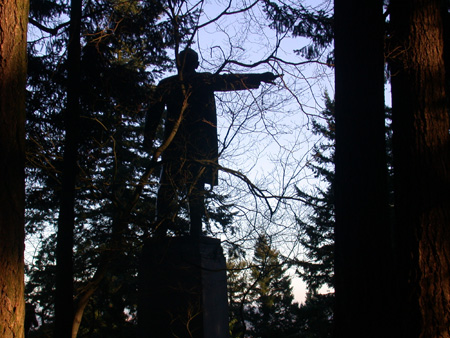
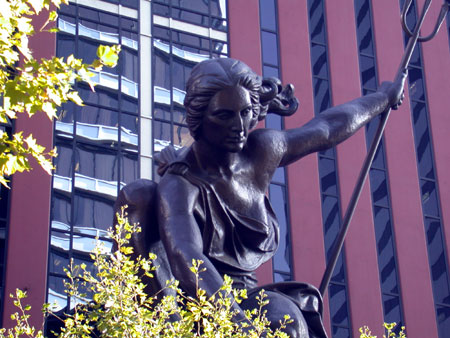 more… »
more… »
Posted by June Underwood on November 9th, 2007
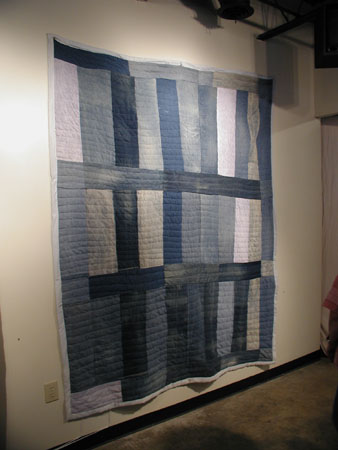
I’ve been following, if not commenting on, the discussions on blogs and their usefulness to a community of artists. And that led me to thinking about communities of artists.
All kinds of communities of artists have existed — ateliers of the Renaissance, –the academies of art — museum schools where students sat on the floor drawing ancient scuptures– the artists who rebelled against the academy in Paris– the Group of Seven took on Emily Carr in the late 1920’s — the New York School whose members drank together at bars, married, divorced, remarried each other– well you get the idea — art camps, colonies, ateliers, workshops, studio spaces, hanging with artists — all comprise community. And now we have the internet, adding another element to the possibility of community.
One of the most fascinating communities of artists is that of the black women of Gee’s Bend, Alabama, whose quilted art was exhibited in Houston and then at the Whitney in 2002. [Michael] Kimmelman in the New York Times November 29, 2002 regarded the exhibit as
“..Some of the most miraculous works of modern art America has produced. Imagine Matisse and Klee (if you think I’m wildly exaggerating, see the show) arising not from rarefied Europe, but from the caramel soil of the rural South in the form of women, descendants of slaves when Gee’s Bend was a plantation. These women, closely bound by family and custom (many Benders bear the slaveowner’s name, Pettway), spent their precious spare time — while not rearing children, chopping wood, hauling water and plowing fields — splicing scraps of old cloth to make robust objects of amazingly refined, eccentric abstract designs. The best of these designs, unusually minimalist and spare, are so eye-poppingly gorgeous that it’s hard to know how to begin to account for them. But then, good art can never be fully accounted for, just described.” (as quoted on the website of Shelly Zegart) more… »
Posted by June Underwood on October 26th, 2007
I’m maundering around Robert Irwin and the concept of perception. It was the Oct 14 NY Times article on Irwin that got me thinking — again — about what and how and why we perceive.
Irwin, in one of his exhibits, made a small but significant change to a San Diego Museum room that overlooked a wide view of the Pacific ocean. His exhibit consisted of cutting three rectangles into the existing windows. The Times quotes Irwin, “At first I didn’t realize the glass was tinted….So not only did my holes let in air and sound, adding another dimension to the experience, but they made everything seen through them appear in greater focus.” The reporter adds that Irwin “opened the window, that age-old pictorial device, letting in a cool rush of reality.”
Alternatively, I think I spend much of my time in reality. So, to reverse Irwin, I’ve been painting “stuff” around my neighborhood base. No sweeping views of vales and rivers, of volcanoes and archaic structures. Instead, I’m trying to perceive, in a painterly fashion, the place I spend most of my time. As usual for me, it consists of much that is “natural,” that is, growing things.
As usual, it’s outside, where I can enjoy the sun (when it shines) and the air and light.
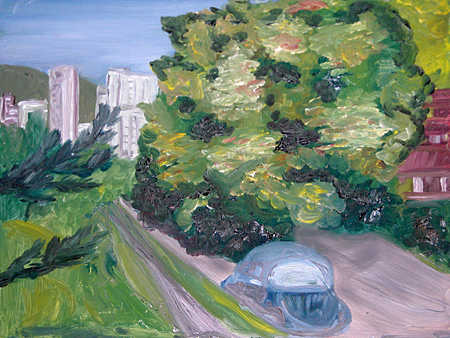 Volkswagen and Horse Chestnut tree, 12 x 16, Pleine aire
Volkswagen and Horse Chestnut tree, 12 x 16, Pleine aire
more… »
Posted by June Underwood on October 12th, 2007
I’m a pushover for powerful art. Are you?

Daniel Chester French. The Lincoln Memorial
And by “powerful” I often mean Big. Big in size, Big in ideas, Big in meaning, Big in its very conception.
more… »
Posted by June Underwood on September 28th, 2007
As an oil painter who tends toward “moosh” rather than clean graphic edges, I have found myself pondering the stitched line intrinsic to my quilted paintings. They change the moosh that I so often fall into, adding a different set of visual ideas.
So, if you’ll forgive me, I want to explore notions of line — line mostly as it is generally described and discussed in design classes, but more particularly as it works in quilted art. [ed. note: This turned out to be more of an essay than I had intended. If you wish, you can just look at the pretty pictures.]
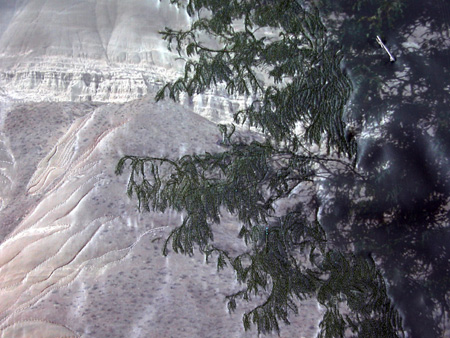
Painted Hills Bluff, detail (Work in Progress)
Line is important in design, particularly, of course, in drawing. It moves the eye, evokes feelings, defines or suggests shape, can make value and depth, and can be varied to vary its expressive quality. In quilted art, line functions in all these ways, but can have a weight and value different from that found in drawing and is far more inportant than line is in painting. In conventional photography, line seems to have minor function, but art photography often makes extensive use of line.
more… »
Posted by June Underwood on September 14th, 2007
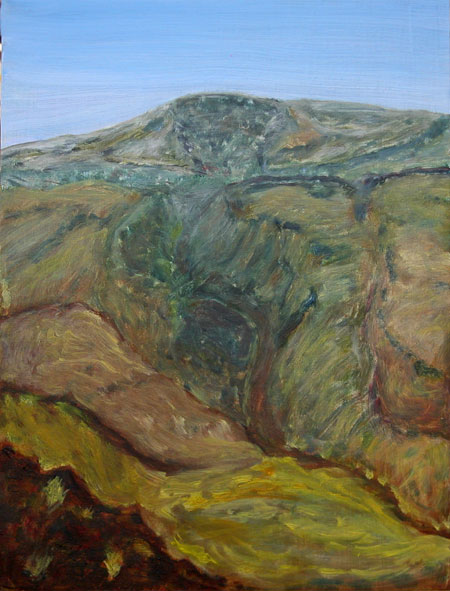
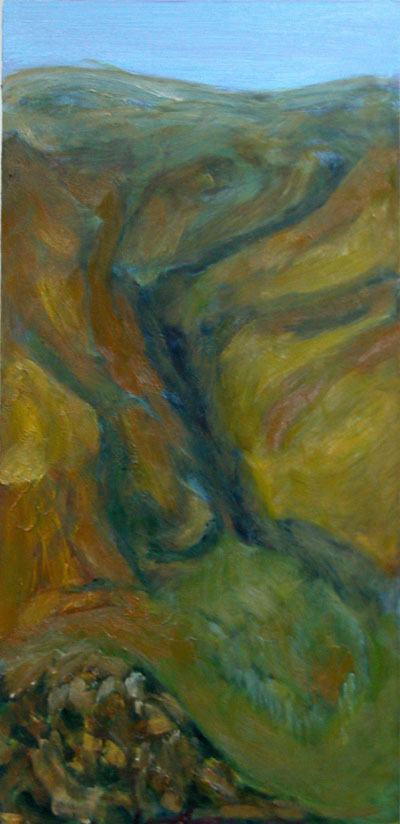
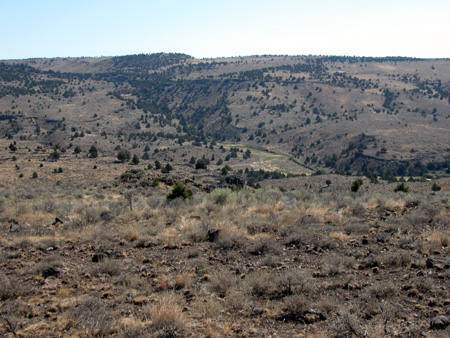
Underwood, Stinking Water Area, large and small oil on masonite, and a photograph, off the Stinking Water Acess Road.
“I took my easel and canvas and brushes to the top of the bluff, and painted two views from the same spot…. From this enchanting spot there was nothing to arrest the eye from ranging over [the Missouri’s] waters for the distance of twenty or thirty miles.”
[Artist George Catlin, as quoted in William H. Truettner, The Natural Man Observed: A Study of Catlin’s Indian Gallery (Washington, D.C.: Smithsonian Institution Press, 1979), p. 247, found on the of the Smithsonian website.
As Karl said (here) one has to become acquainted with the landscape before one can paint it. And as George Catlin remarked about a different landscape “there was nothing to arrest the eye…for the distance of twenty or thirty miles.
Aside from artistic masochism, why do we paint landscapes?
more… »





 Volkswagen and Horse Chestnut tree, 12 x 16, Pleine aire
Volkswagen and Horse Chestnut tree, 12 x 16, Pleine aire



